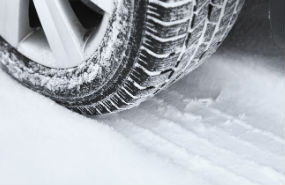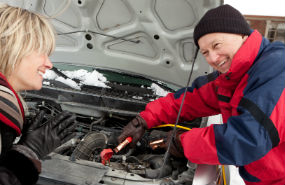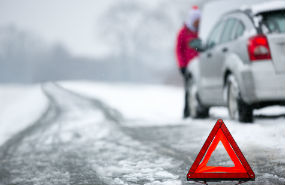Car Insurance Guide: Driving in Winter
Winter is one of the most dangerous times for drivers. While the season brings with it plenty of festivities, so too comes frost, sleet and long nights that make for high-risk, low-visibility driving.
Thankfully, there are some steps that motorists can take to minimise their risk of breakdowns or collisions during the colder months.
Swinton Insurance has put together an in-depth guide that outlines how you can prepare your vehicle for winter driving, some practical tips while you’re on the road, and what to do if your car breaks down.
Preparing your vehicle for winter
One of the most important things you can do to help reduce the risks of driving in winter is to check that your vehicle is ready for the cold. But it’ll take more than just checking that the heating works to keep you safe.
Here are some things you should consider before driving in winter — and what you can do when things aren’t quite up to scratch.
Basic winter checks
Before you set off anywhere, there are some basic spot-checks you can do to make sure you’ll be able to drive safely:
- Windows - Frost can quickly build up on your windows overnight, which is particularly dangerous on the windscreen. Use a de-icer or ice scraper on your car windows to clear ice before you drive; don’t rely on your car heater to melt it all away.
- Demisters - When you start your car in low temperatures, your windscreen can often mist up quickly due to the contrast in temperature between the inside of the car and the glass. Check that your demisters are working properly before driving your car.
- Lights - There are only eight hours of sunlight a day in December and January, so it’s critical that all your lights — headlights, brake lights and reversing lights — are working properly before you drive. Faulty headlights could make it difficult for you to see the road ahead, and faulty tail lights mean drivers behind you won’t see you properly, increasing the risk of collision. Plus, you can incur a serious fine if you’re stopped by the police.
- Wing mirrors - While a misty or frosty windscreen is obvious, many drivers forget to check their wing mirrors before taking their car off the drive. This is dangerous because it’s incredibly difficult to demist wing mirrors while you’re driving. Ensure you check each wing mirror before you get into your vehicle.
Getting a full mechanical check
While basic spot checks will help you in winter, not everything at fault with your vehicle can be easily seen from the outside. That’s why it’s important to take your car in for a mechanical check at the beginning of the winter season.
You can take your car to a local fast fit centre for a basic mechanical check. Many garages will offer them free of charge, or as a complimentary service when your car is in the shop.

Winter tyres
In winter, road conditions dramatically change too. 48% of winter car accidents in the UK are a result of skidding (source: Car Shop), so having the best tyres for road handling is very important.
Ideally, you need to switch to winter tyres for optimum performance in low temperatures for driving on ice, slush, snow and wet ground.
Here’s what winter tyres give you that normal tyres won’t:
- Low-temperature performance — Winter tyres have improved performance at temperatures below 7 degrees C. Temperatures can fall below 7 degrees C for over 120 days every 12 months — that’s a third of the year. Winter tyres are made using a different rubber compound so they don't harden at low temperatures. This gives them better braking and traction on snow and ice, as well as wet roads.
- Winter tyres have shorter stopping distances — A typical saloon car travelling at 30 mph with normal tyres comes to a standstill on a snow-covered road after 43 metres. With winter tyres, it would come to a halt after just 35 metres. That’s a reduction in brake distance of almost 20%, which can significantly reduce the likelihood of a collision.
- Resistance to aquaplaning — Melting snow can cause large puddles across roads, increasing the risk of aquaplaning, which happens when the water at the front of your tyres builds up too quickly and sprays out behind, causing you to lose control. Unique winter tyre treads are designed to better evacuate water to prevent this build-up
- Legal requirement — Some countries make it a legal requirement to have the right tyres fitted in winter. For example, drivers in Austria can face a fine of up to 5,000 EUR for having the wrong tyres on their car.
If you choose to use the same tyres all year round, regularly checking their tread, pressure and condition is vital.
Packing an emergency breakdown kit
Breaking down in winter is far from an ideal situation, but taking the time to prepare an emergency breakdown kit — especially if you’re going on a long car journey — could make the experience a lot easier on you and your passengers.
Here are the essential things you should pack and keep in your car for any winter journey.
- Mobile phone (fully charged) and an in-car charger — Try to make sure your phone is always fully charged before setting off. Cold weather will actually run your phone battery down quicker than usual.
- De-icer and a scraper — Severe weather can freeze your windows. Applying de-icer and using a scraper is the fastest and safest way to remove frost on your windscreen.
- A battery jump-start kit or jump leads — Much like your phone battery, car batteries are more vulnerable in the cold.
- Emergency rations — Energy or chocolate bars and long life drinks are best, but consider taking a warm drink in a flask with you too.
- A telescopic or foldable snow shovel — The size can be adjusted and kept in your boot in case your car gets snowed in.
- Tow rope — If you’re wedged in snow and need help, a tow rope could prove invaluable. On the other hand, you may come across another motorist who needs help.
- A small container of salt or sand — If your wheels are stuck in snow or on ice, sprinkle the rock salt (table salt works too, although not as well) or sand in front of your tyres. The salt will help melt the
ice/snow and the sand will give your wheels extra grip.
You should also keep the following items in your car at all times:
- First-aid kit
- A hazard warning triangle
- Hi-vis vest
- Bottled water
- Warm clothes, a waterproof jacket and a blanket
- A torch with spare batteries

What you shouldn’t do to your car in winter
While forcing open a frozen window or pouring hot water over an icy windscreen is a fast way to solve an immediate problem, it can have catastrophic effects on the long-term health of your car.
By following our advice, you can avoid doing more harm than good and ensure your vehicle makes it to spring in great condition.
1. Don’t breathe on frozen locks
Breathing on a frozen lock to help melt or loosen up ice is not a good idea, despite what you may have heard. If you breathe on a lock that’s frozen over, the moisture from your breath could condense inside and actually make things worse.
There are specific lock de-icers available that you can buy when the cold weather sets in. There are also products available that can prevent locks becoming frozen in the first place; be aware, though that using them can often attract dirt and grime over time, which may make your lock stiff or even become completely stuck.
2. Don’t pour boiling water on a frozen windscreen
Pouring boiling water on your windscreen is, without doubt, the fastest way to clear away frost — but the shift in extreme temperatures can crack or even shatter the glass. For this reason, you should never pour hot water on your windscreen.
Your best bet is to use a recognised de-icer spray. As an alternative, use a salt and water mixture to clear away the ice; table salt will do. Saltwater freezes at a lower temperature than normal water and so it will melt the ice away, in the same way road salt is used to melt ice on the roads. Be careful not to use too much saltwater, though — all you need is a splash.
Finally, it’s a good idea to cover your windscreen during the night if you know there’s cold weather on the way. If you don’t have a cover, you can use an old blanket instead.
3. Don’t use anything other than a proper scraper
If you want to scrape ice from your frozen windscreen, use an ice scraper. Using anything else could result in damage to the glass.
Using things like a credit card, a CD case or anything with a metal edge can result in scratches on the glass.
4. Don’t reduce tyre pressure to increase grip when driving
You might have been told that reducing your tyre pressure will result in a better grip on the road in icy or snowy conditions. This is not true and, in fact, can make driving in harsh conditions worse, because you’ll lose some stability.
Ensure that your tyre pressure is checked and kept at a safe level throughout the winter because it can drop in cold weather. If you can afford winter tyres, it’s always recommended to get them fitted.
5. Don't force frozen doors or windows
Aside from a frozen windscreen, you’re also likely to experience frozen doors and windows during the winter months. If your car door is frozen, try pouring warm water (not boiling) over the handle and seal of the door. This should melt the ice and allow you to open it.
If you have electric windows and they freeze, don’t keep pressing the button to roll the windows down. This can quickly burn out the motor, making your windows unusable. Most likely, the window is frozen to the weatherstrip on the outside of the car so the best thing to do is wait until the inside of your car warms up.
6. Stop driving if your engine squeals
A continuous squealing noise as soon as the engine is started during cold weather is a sign your water pump is frozen. The best thing to do is to stop the engine immediately and allow it to thaw out naturally. Depending on the weather, this may take several days unless the car can be moved to a heated garage.
If the car begins to overheat, it's likely that the radiator has frozen, which is preventing coolant from circulating. Stop straight away to avoid serious damage and allow the radiator to thaw. You can prevent your radiator from freezing in the first place by keeping an eye on your engine coolant levels. Refer to your user’s manual where you’ll find all the relevant information on how best to do this for your car mode
7. Don’t leave snow on top of your car
Clearing the ice from windows is important, but remember to also clear snow from the top of the vehicle too. If you don’t clear it there’s always the chance it will fall onto your windscreen while driving or even blow off into the path of another driver’s car while on the road. It can be a real hazard.
Leaving snow on the top of your car can be seen as a violation of the highway code, so you could be met with a substantial fine if you’re pulled over by the police.

What to do if your car breaks down in winter
Whether you’re at the roadside, or on a motorway, it’s important you know what to do if your car breaks down. That’s doubly important in winter, when the long nights and harsh weather can make it especially risky to be by the roadside.
With that in mind, here are some essential tips you should follow if your car breaks down in winter.
What to do if you break down on the motorway
1. Make sure your car is visible
Pull onto the hard shoulder as far left as you can go, with your wheels turned to the left. Then, turn on your hazard lights and sidelights to let other drivers know you’re in trouble.
2. Leave your vehicle safely
If you breakdown on a motorway, you should leave the vehicle. Do so via the left door; never use the side nearest the road. If you have children with you, always take them out of the car on the passenger side. Leave pets in the car unless you feel they are in genuine danger.
3. Stay safe and warm behind the barrier
Keep behind the motorway barrier to stay safe. Carry hi-vis jackets as well as warm and waterproof clothing if possible. It’s important to be clearly visible to other drivers, especially on dark winter mornings and evenings, and you don’t know how long you’re going to have to wait for your breakdown recovery service to arrive.
4. Call for help
Store your breakdown provider's number in your phone. If you don’t have a mobile phone with you, then look out for an emergency phone along the motorway. They’re painted bright orange, and there’s one every mile. Follow the arrows on the hard shoulder to point you in the direction of the nearest one. Don’t carry out any roadside repairs no matter how simple you think they might be.
What to do if you breakdown at the roadside
1. Make sure your car is visible
Pull in somewhere safe or as far left to the roadside as you can go, with your wheels turned to the left. Then, turn on your hazard lights and sidelights.
2. Stay safe and warm inside your car
Stay in your car if you feel it’s safe to do so but remember to keep warm. If you’re snowed in and can’t drive any further, run your engine occasionally to keep the inside of the car warm but make sure you have a window open and the exhaust isn’t blocked. You should also, if possible, carry some extra warm and waterproof clothes in case you can’t stay in the car until the recovery service arrives.
3. Put out a warning triangle
It must be at least 45 metres behind your vehicle on the same side of the road. Leave the vehicle via the left door and never the side nearest the road.
4. Call for help
Make sure you have a fully-charged mobile phone with you to call for help. It’s also a good idea to store your breakdown provider's number on there. If you’re worried about conserving your battery life, disable your Bluetooth and mobile data.
Stay protected this winter
While driving in winter is never 100% safe, taking the right precautions can drastically reduce your likelihood of being involved in an accident. Preparing your vehicle properly, packing the right emergency supplies and avoiding some common mistakes people make when trying to get their car off the drive quickly means that you and your vehicle will most likely cruise into spring safe and sound.
Of course, accidents do happen. Making sure you have the right Car Insurance policy in place is crucial to make sure that, should you be involved in a collision, you have the proper financial support.
Find out why you should choose a Swinton Car Insurance policy this winter today.


